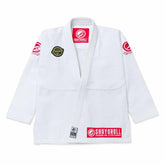Why Did BJJ Become the New Karate?
For decades, Karate was the martial art that defined discipline, honor and physical prowess. It was a household name, embedded in pop culture through movies, dojos and even video games. However, the last two decades have seen a major shift. Brazilian Jiu Jitsu (BJJ) has emerged as the new face of martial arts. It is not famous just among fighters, fitness enthusiasts and self-defense advocates. But the parents are also enrolling their kids in BJJ academies. So, what led to this evolution? Why did BJJ become the new Karate?
Let’s dive deep into the cultural, technical and practical reasons behind this seismic shift in the world of martial arts.
From Dojo to Cage: Karate’s Rise and Plateau
Karate originated in Okinawa and became popular globally in the mid-20th century. Its rise in the West was fueled by Hollywood. Films like The Karate Kid turned martial arts into mainstream entertainment. Thus, promoting the ideals of respect, discipline and self-mastery.
However, as Mixed Martial Arts (MMA) began gaining traction in the early 2000s, Karate's dominance started to wane. The flashy high kicks and rigid stances began to look outdated against the backdrop of the brutal efficiency showcased in the UFC octagon. Fighters needed more than kata and point sparring. They needed grappling, submissions and ground control.
Enter Brazilian Jiu Jitsu (BJJ): A Game Changer
Brazilian Jiu Jitsu exploded onto the global stage with the introduction of the Ultimate Fighting Championship (UFC) in 1993. The first tournament was dominated by Royce Gracie. He was a relatively small man who submitted larger opponents using BJJ techniques. This changed the perception of what effective combat looks like.
Where Karate emphasized striking, BJJ focused on leverage, technique and submission holds, especially on the ground. It was practical, versatile and deeply effective — especially in a real fight.
Key Differences Between BJJ and Karate
To understand why BJJ became the new Karate, it is essential to look at how these two martial arts differ in approach, training and application.
| Feature | Karate | Brazilian Jiu Jitsu (BJJ) |
|---|---|---|
| Style | Striking (punches, kicks) | Grappling, submissions, ground control |
| Focus | Forms (Kata), point fighting | Live sparring, rolling |
| Training Gear | Karate Gi | BJJ Gi, No-Gi rash guards |
| Combat Range | Stand-up, mid to long range | Close contact, ground game |
| Practicality in MMA | Limited without cross-training | Highly effective and essential |
| Fitness Benefits | Flexibility, cardio, coordination | Full-body strength, endurance, mental resilience |
Why BJJ Is Winning the Popularity Contest
1- Effectiveness in Real Fights and MMA
In both street self-defense and professional fighting, BJJ reigns supreme. MMA fighters with solid BJJ skills have a huge advantage, especially in takedowns, positional control and submissions. Karate, while useful, often requires supplementation with other arts for well-rounded combat readiness.
2- Real-Time Application in Sparring
BJJ is not like Karate which often involves controlled sparring or forms. However, BJJ practitioners “roll” live in almost every class. This means techniques are tested against resisting opponents constantly. Hence, enhancing adaptability and situational awareness.
3- Inclusive for All Ages and Sizes
BJJ's philosophy revolves around using leverage and technique to overcome size and strength. This makes it ideal for kids, women, and older practitioners. The BJJ community is widely inclusive and welcoming to beginners.
4- BJJ Gi Culture and Ranking System
Like Karate, BJJ also has a belt system — white to black. But the journey is significantly longer and based on performance, not just time. The BJJ Gi is a core part of the training, emphasizing grips, throws and submission setups. There is also a growing trend in No-Gi BJJ. No-Gi BJJ appeals to those who want a faster, more athletic grappling style.
5- Fitness and Mental Benefits
BJJ provides a full-body workout and mental discipline. Grappling requires problem-solving, quick thinking and patience. As such, BJJ practitioners often report improved confidence, mental health and overall fitness. Thus, making it a lifestyle — not just a sport.
Pop Culture & The Modern BJJ Movement
Just as Karate had its cultural boom with Bruce Lee and Chuck Norris, BJJ is now enjoying a similar rise. Big names like Joe Rogan, Keanu Reeves, Tom Hardy and Demi Lovato are BJJ practitioners. Social media is flooded with BJJ content. Moreover, the rise of platforms like FlowGrappling and IBJJF (International Brazilian Jiu-Jitsu Federation) has helped spotlight athletes globally.
Moreover, top MMA champions like Charles Oliveira, Demian Maia and Gilbert Burns are proud BJJ black belts who have carried the art's reputation in high-stakes competitions.
Is BJJ Replacing Karate in Schools?
Increasingly, schools and martial arts academies are offering BJJ instead of (or alongside) traditional Karate programs. The dynamic, hands-on approach of BJJ is seen as more relevant for today’s self-defense needs. Parents are drawn to the practical skills and confidence their children gain on the mats.
Moreover, the competitive scene of BJJ tournaments — both Gi and No-Gi — is rapidly growing. Thus, giving kids and adults exciting goals beyond belt promotions.
The Evolution of Martial Arts: Not a Replacement, But a Revolution
It is important to note that BJJ has not replaced Karate entirely. Instead, it has shifted the spotlight. Karate remains valuable — especially for developing discipline, structure and striking fundamentals. However, Brazilian Jiu Jitsu has redefined modern martial arts by adapting to the demands of real combat and dynamic competition environments.
In today’s martial arts ecosystem, many elite fighters train in both Karate and BJJ, using them in tandem. But for the new generation of martial artists, BJJ is what Karate was in the 80s and 90s — a symbol of effectiveness, respect and evolution.
Final Thoughts
Brazilian Jiu Jitsu did not just become the new Karate by accident. But it earned that title through years of proven effectiveness, inclusivity and cultural relevance. Whether you’re looking to compete, stay fit, defend yourself or find a new passion, BJJ is the martial art of the modern era.
And if you are already training in a BJJ Gi, rolling with your teammates, and chasing that next belt promotion — you are part of a global movement that is reshaping martial arts for generations to come.







